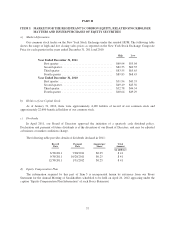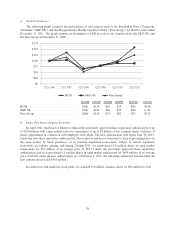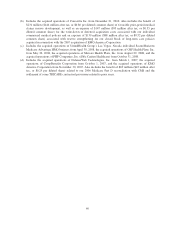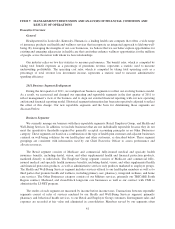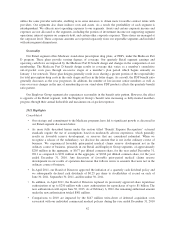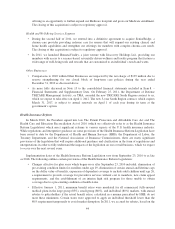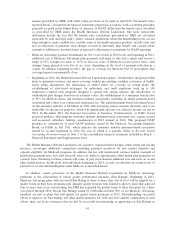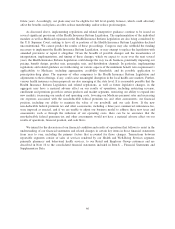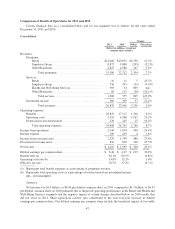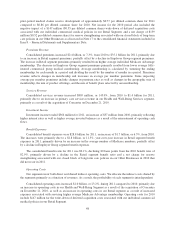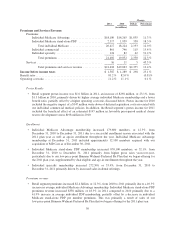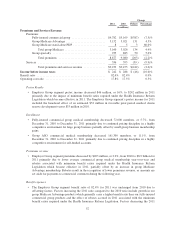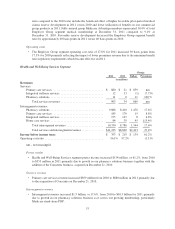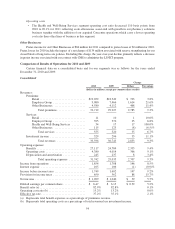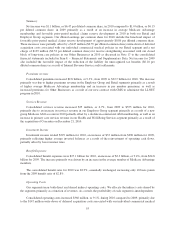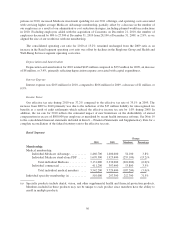Humana 2011 Annual Report Download - page 56
Download and view the complete annual report
Please find page 56 of the 2011 Humana annual report below. You can navigate through the pages in the report by either clicking on the pages listed below, or by using the keyword search tool below to find specific information within the annual report.future years. Accordingly, our plans may not be eligible for full level quality bonuses, which could adversely
affect the benefits such plans can offer, reduce membership, and/or reduce profit margins.
As discussed above, implementing regulations and related interpretive guidance continue to be issued on
several significant provisions of the Health Insurance Reform Legislation. The implementation of the individual
mandate as well as Medicaid expansion in the Health Insurance Reform Legislation are also being considered by
the U.S. Supreme Court, seeking to have all or portions of the Health Insurance Reform Legislation declared
unconstitutional. We cannot predict the results of these proceedings. Congress may also withhold the funding
necessary to implement the Health Insurance Reform Legislation, or may attempt to replace the legislation with
amended provisions or repeal it altogether. Given the breadth of possible changes and the uncertainties of
interpretation, implementation, and timing of these changes, which we expect to occur over the next several
years, the Health Insurance Reform Legislation could change the way we do business, potentially impacting our
pricing, benefit design, product mix, geographic mix, and distribution channels. In particular, implementing
regulations and related guidance are forthcoming on various aspects of the minimum benefit ratio requirement’s
applicability to Medicare, including aggregation, credibility thresholds, and its possible application to
prescription drug plans. The response of other companies to the Health Insurance Reform Legislation and
adjustments to their offerings, if any, could cause meaningful disruption in the local health care markets. Further,
various health insurance reform proposals are also emerging at the state level. It is reasonably possible that the
Health Insurance Reform Legislation and related regulations, as well as future legislative changes, in the
aggregate may have a material adverse effect on our results of operations, including restricting revenue,
enrollment and premium growth in certain products and market segments, restricting our ability to expand into
new markets, increasing our medical and operating costs, lowering our Medicare payment rates and increasing
our expenses associated with the non-deductible federal premium tax and other assessments; our financial
position, including our ability to maintain the value of our goodwill; and our cash flows. If the new
non-deductible federal premium tax and other assessments, including a three-year commercial reinsurance fee,
were imposed as enacted, and if we are unable to adjust our business model to address these new taxes and
assessments, such as through the reduction of our operating costs, there can be no assurance that the
non-deductible federal premium tax and other assessments would not have a material adverse effect on our
results of operations, financial position, and cash flows.
We intend for the discussion of our financial condition and results of operations that follows to assist in the
understanding of our financial statements and related changes in certain key items in those financial statements
from year to year, including the primary factors that accounted for those changes. Transactions between
reportable segments consist of sales of services rendered by our Health and Well-Being Services segment,
primarily pharmacy and behavioral health services, to our Retail and Employer Group customers and are
described in Note 16 to the consolidated financial statements included in Item 8. – Financial Statements and
Supplementary Data.
46



